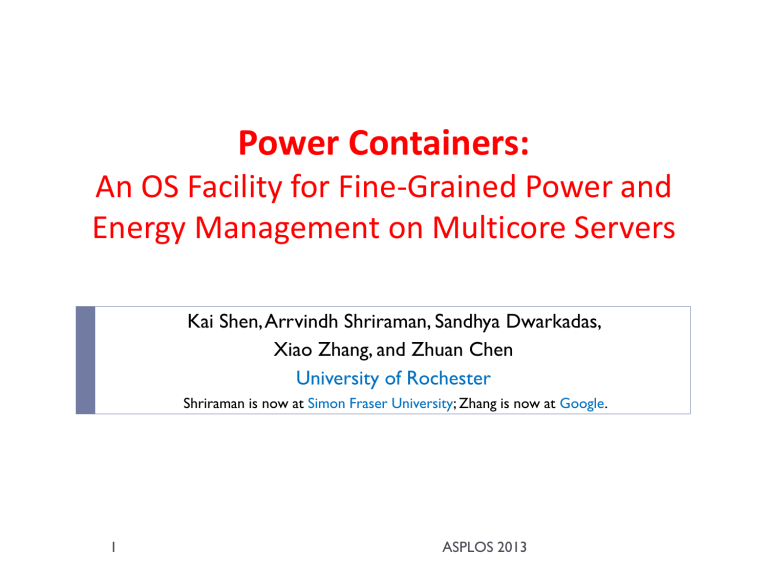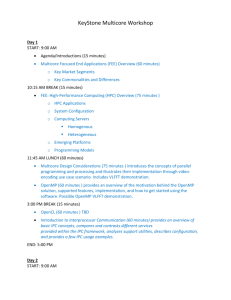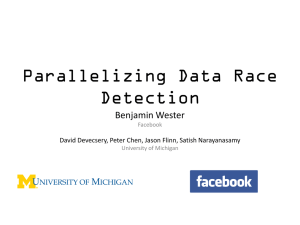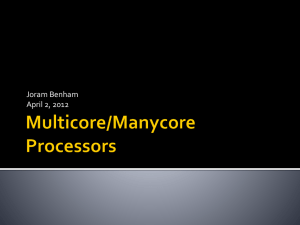Power Containers: An OS Facility for Fine

Power Containers:
An OS Facility for Fine-Grained Power and
Energy Management on Multicore Servers
Kai Shen, Arrvindh Shriraman, Sandhya Dwarkadas,
Xiao Zhang, and Zhuan Chen
University of Rochester
Shriraman is now at Simon Fraser University ; Zhang is now at Google .
1 ASPLOS 2013
Problem Overview
Power/energy are important for data centers and servers
Dynamic power usage on modern hardware
Power proportionality : 5% idle power on Intel SandyBridge
Workload dependency : 3:2 power ratio on same machine
A server runs many requests from users
Request is basic unit of userinitiated work
Carbon footprint of a web click?
Power viruses in cloud
Request is basic unit of load distribution
2
Motivations for per-request power accounting and control
ASPLOS 2013
Power Containers on Multicore Servers
Challenges :
Concurrenct , fine-grained request activities over multiple stages
Complex multicore power sharing ; insufficient direct measurement
Approach :
Event-based power modeling + request tracking
Contributions on power modeling:
Account for multicore shared power
Use online measurement to mitigate power model inaccuracy
Contributions on request tracking:
Online request tracking and control
OS support transparent to applications
3 ASPLOS 2013
Multicore Power Attribution to Concurrent Tasks
Bellosa’s event-based power model
Assumes direct relationship between one’s physical activities (instructions, cache references, bus activities, …) and power
On a multicore, maintenance of shared resources consumes power when at least one core is active
Such shared power is not affected by one’s own physical activities, but rather depends on the level of multicore sharing
Our approach: evenly attribute to concurrently running requests
Implemented efficiently by local estimation of multicore sharing level (to avoid expensive global coordination and cross-core interrupts)
4 ASPLOS 2013
Measurement-Assisted Online Model Correction
Classic event-based power modeling is being questioned
[McCulough et al. 2011] shows pessimistic results
We find large model errors due to different characteristics between production and calibration workloads (worst for unusual workloads)
Our approach
Online power measurement can help re-calibrate power model
Measurement has delays, needs alignment with modeled power
5 ASPLOS 2013
Request Power Accounting
Request context tracking in a multi-stage server
Past techniques either require offline analysis, or at application level
Request from client
Our approach
Track request propagation events (sockets, forks, …) at the OS
Attribute and control power at proper request context
Imperfect now: miss 1/3 of power in GoogleAppEngine Response to client
Apache httpd
16.8W, 0.29J
socket
MySQL thread
14.7W, 0.04J
socket socket
... … … ...
socket
Apache httpd
14.5W, 1.78J
Shell
14.4W, 0.07J
fork “latex” process fork
14.4W, 0.53J
wait4ex it exit fork wait4ex it exit
“dvipng” process fork
16.3W, 0.29J
wait4ex it exit wait4ex it exit socket socket socket exit socket
6 ASPLOS 2013
Online Overhead
Overhead depends on frequency of periodic activities; low overhead (<1%) for sufficiently frequent activities
Periodic maintenance of power containers
Reading hardware counters, power modeling, updating request stats 2948 cycles, 1656 instructions, 16 floating point ops, 3 LLC refs 1µsec,
10 µJs
Online model recalibration
Computation of least-square linear regression (16 µsecs for ~30 samples)
7 ASPLOS 2013
Request Power Accounting Results
Distribution of average request power
Distribution of request energy usage
8 ASPLOS 2013
Validation of Request Power Accounting
Challenge of validation:
Hard to know the ground truth – no way to directly measure request power or energy use on a multicore server
Validation approach #1:
Aggregate accounted request energy over a time duration to estimate total system energy usage; then match with measurement
No more than 9% error across six workloads on three machines
Validation approach #2:
Use accounted request energy to estimate system energy usage at hypothetical workload conditions (different mixes/rates of requests)
No more than 11% error for workloads with stable-behavior requests
9 ASPLOS 2013
Fair Request Power Conditioning
Control max power use of a server machine
Set equal per-request power budget for fairness
Power containers track request power usage, throttle high-power requests using core duty-cycle modulation
A case study of Google App Engine with power viruses
Keep max power at 40Watts
Power containers: 33% slowdown for power viruses; 2% slowdown for normal requests
Alternatively slow down all requests indiscriminately (13%) to lower the max power
10 ASPLOS 2013
Heterogeneity-Aware Request Distribution
Different workloads/requests exhibit different levels of machine preferences in energy efficiency
Energy usage on Intel SandyBridge over energy usage on Woodcrest
Power containers can capture fine-grained request energy profiles and distribute load in a server cluster for high efficiency
Case study shows 25% energy saving compared to alternatives
11 ASPLOS 2013
Conclusions
High-level messages:
Fine-grained power accounting and control are important for multicore server efficiency and dependability
Increasingly so on more power-proportional hardware and dynamic-behavior workloads (web 2.0, cloud computing, …)
Possible to support these at the OS (on today’s processor hardware, requiring no application assistance)
New techniques:
Enhanced modeling to account for multicore shared power
Use online measurement to mitigate power model inaccuracy
OS-level online request tracking and control
12 ASPLOS 2013








